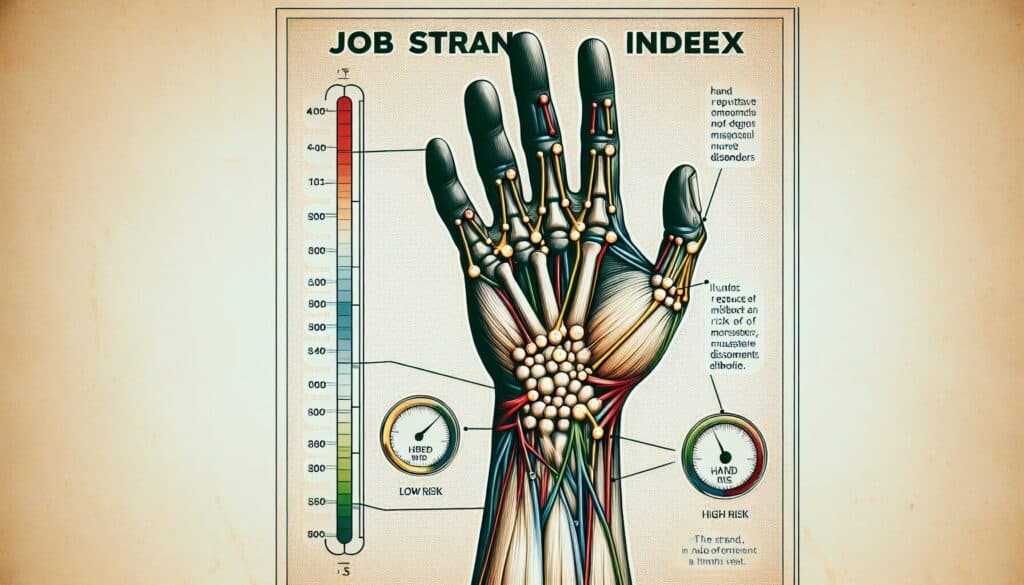Un metodo per valutare il rischio di disturbi muscoloscheletrici della mano, del polso, dell'avambraccio e del gomito, principalmente associati a sforzi ripetitivi e di forza.
- Metodologie: Clienti e marketing, Ideazione, Progettazione del prodotto
Indice di stress lavorativo (JSI)

Indice di stress lavorativo (JSI)
- Miglioramento continuo, Ergonomia, Scienze della salute, Fattori umani, Produzione snella, Miglioramento dei processi, Gestione della qualità, Gestione del rischio, Sicurezza
Obiettivo:
Come si usa:
- Calcola un punteggio in base all'intensità dello sforzo, alla durata dello sforzo per ciclo, agli sforzi al minuto, alla postura delle mani e dei polsi, alla velocità del lavoro e alla durata del compito al giorno. Un punteggio superiore a una soglia indica un lavoro pericoloso.
Professionisti
- Relativamente semplice e veloce da applicare una volta raccolti i dati; si concentra sui fattori di rischio chiave per i disturbi dell'arto superiore distale; fornisce un unico punteggio di rischio.
Contro
- Considera un numero limitato di fattori di rischio; può non essere adatto a tutti i tipi di attività dell'arto superiore; si basa sulla stima soggettiva di alcuni fattori.
Categorie:
- Ergonomia
Ideale per:
- Valutazione del rischio di sviluppare disturbi muscoloscheletrici agli arti superiori distali a causa delle mansioni lavorative.
The Job Strain Index (JSI) is particularly beneficial in various sectors that involve manual labor, such as manufacturing, construction, healthcare, and warehousing, where workers are susceptible to musculoskeletal disorders. This methodology is most effectively applied during the ergonomics assessment phase of workplace design or during the evaluation of existing job tasks to identify risks associated with specific work activities. It is typically initiated by occupational health and safety professionals, ergonomists, or human factors specialists, often in collaboration with workers, supervisors, and management to ensure a comprehensive understanding of job demands and work environments. The process includes observational studies and data collection on workers’ tasks, thereby engaging different stakeholders in the evaluation process, including engineers looking to improve postazione di lavoro designs and occupational therapists assessing the impact of job requirements on individual health. The JSI score serves as a quantifiable measure that can drive interventions, such as redesigning tasks to minimize risk factors, implementing job rotation strategies, or offering training to modify manual handling techniques. Its user-friendly nature allows for quick on-site evaluations, making it a practical tool during safety audits or in the development of workplace initiatives that aim to enhance worker well-being while maintaining productivity standards. By providing a clear numerical risk assessment, JSI aids in prioritizing actions needed for improvement, offering a straightforward approach to risk management in operational settings.
Fasi chiave di questa metodologia
- Determine the intensity of exertion for each task using a standardized scale.
- Evaluate the duration of exertion per cycle for each identified task.
- Count the number of efforts applied per minute for relevant tasks.
- Assess hand/wrist posture during each task using defined criteria.
- Measure the speed of work for each task as part of the analysis.
- Estimate the duration of the task performed each day.
- Calculate the Job Strain Index score by combining all the assessed parameters.
- Compare the calculated score against established threshold values to determine risk level.
Suggerimenti per i professionisti
- Integrate task observations with JSI calculations to capture real-world variations in exertion levels and to inform design adjustments.
- Utilize the JSI data as a baseline for iterative design changes and re-evaluate periodically to track the effectiveness of ergonomic interventions.
- Collaborate with multidisciplinary teams to assess context-specific variables such as environment and workflow, enhancing the accuracy of the JSI application.
Leggere e confrontare diverse metodologie, raccomandiamo il
> Ampio archivio di metodologie <
insieme ad altre 400 metodologie.
I vostri commenti su questa metodologia o ulteriori informazioni sono benvenuti su sezione commenti qui sotto ↓ , così come tutte le idee o i link relativi all'ingegneria.
Contesto storico
1986
(se la data non è nota o non è rilevante, ad esempio "meccanica dei fluidi", viene fornita una stima approssimativa della sua notevole comparsa)

Post correlati
Questionari sul disagio muscoloscheletrico
Test multivariati (MVT)
Analisi di regressione multipla
Sistemi di cattura del movimento
Metodo MoSCoW
Test mediano dell'umore